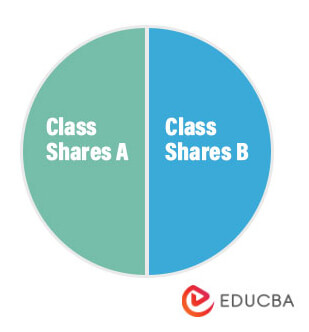Updated July 19, 2023
Introduction to Share Classes
A corporation assigns Share Classes to classify the shares issued by it into different classes based on differences in shares on account of voting rights, privileges, and restrictions.
To give separate classifications, these are assigned to categories of shares having similar characteristics, such as Class A shares, Class B shares, and so on.
Explanation
A company may issue different classes of shares carrying other characteristics. These characteristics include voting rights, privileges, as well as restrictions. The two common types include Class A and Class B. All shares issued in a particular class would have similar rights and privileges. A company issues shares of different classes if it wishes to restrict the control to a limited set of shareholders.
Example
A company issues two classes of common stocks, namely Class A and Class B. The description of both is given below:
- Class A: Each unit of common stock carries one voting right
- Class B: No voting right is available to the stockholders
Here, the company has issued two stocks based on the difference in voting rights. While Class A shares entitle the stockholders to one vote per share, Class B shares don’t confer any voting rights to the shareholders.
Types of Share Classes
There are mainly two types of common stock, namely Class A and Class B.
- Class A Shares: Class shares have higher voting rights than Class B shares. The charges relating to its purchase are high, and the annual expenses are lesser than Class B shares. Class A shares have a preference over dividends in the event of dividend distribution.
- Class B Shares: The stockholders of Class B get lower voting rights than stockholders of Class A shares. The annual expenses are higher in these shares, and the initial charges relating to purchase are less. Class B shares have less priority in dividend distributions. A company may decide to issue other classes of shares and define their features with respect to restrictions, voting rights, benefits, and so on.
Importance of Share Classes
These define the rights and restrictions attached to the stock units. Thus, it becomes very important for investors to understand the class of shares the company is issuing. The investment decision will be influenced by the nature of the shares being issued. If a class of shares indicates that priority will be given to shareholders of another class in terms of dividend distribution, it means that the shareholders of the new class may not receive dividends if there are insufficient profits available. This uncertainty in dividend payments may deter investors who rely on regular income from dividends. They may prefer to invest in other classes of shares where dividend payments are more assured to shareholders. There are different criteria that an investor considers in the classes of shares before investing.
Benefits
- The company can manage the control of the company by restricting it to a certain class of shares. It may decide to give controlling rights to one class of shares and less controlling rights to another class, and hence, it can effectively manage the control.
- The corporation might also prioritize some shares for dividend distributions over others.
- Certain classes of shares can have limitations and restrictions on the distribution of the company’s assets in the event of liquidation.
- The concept is primarily helpful to start-up companies since it allows them to obtain funds without compromising the promoters’ control, ensuring that there is no interference in the decision-making process.
Disadvantages
- If a superior class of shares is established, shareholders may feel estranged from the company because their rights and advantages would be reduced.
- If a class of shares having preferential voting rights, i.e., higher voting rights, is issued, the original shareholders may be concerned since control is diluted and the voting rights of such initial shareholders are lowered.
Conclusion
It is very common for companies to issue shares with different classes. The most common share are Class A and B, where the shareholders of Class A get higher voting rights and preference in dividends. However, it is essential to check the class description to understand the rights and benefits available to the shareholders since all companies might not do similar classifications.
Recommended Articles
This is a guide to Share Classes. Here we discuss the definition and types of classes along with their benefits and disadvantages. You may also have a look at the following articles to learn more –





